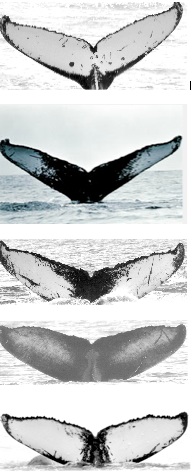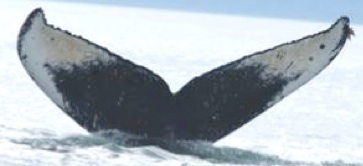
Home Methods 1 | Photo Identification | Mark and Recapture Biopsy | Summer Feeding Areas, Wintering Grounds and Migration | Human Impact | Population Estimates
Activity 1: Questions about SPLASH | Activity 2: Interpreting Graphs | Activity 3: Mark and Recapture | Activity 4: Estimating Humpback Population Growth | Activity 5: Whale Tails: Photo ID | Activity Answers
| In the the 1970’s, whale biologists on the east coast discovered that the underside of each humpback whale’s tail flukes has a unique pattern. Scientists photographed the flukes of the whale, made notes on the location, and associations with other whales. The photograph was then “matched” with other photos of a particular whale. This method became known as Photo ID and it is an important tool for whale biologists studying humpbacks. From this data whale biologists are able to make abundance estimates of a humpback population; study local and migratory movements of whales; and keep track of the age of a particular whale. Almost 19,000 quality fluke identification photographs were taken on 27,000 approaches of humpback whales during the SPLASH study. The management of the photo ID data base was critical to the success of SPLASH. At the end of each field season, contributors would send their best photographs to regional coordinators, who were responsible for organizing all data from their area of the Pacific (ie Hawaii, Russia). This data was sent to a central data bank at Cascadia Research.The diligent team at Cascadia spent hundreds of hours matching photographs from within a region and making cross-regional matches (ie Hawaii and Southeast Alaska). As a result of all this tedious work, a total of almost 8,000 unique individuals were cataloged during the study. Photo ID was a critical part of the success of the SPLASH study. Years ago, biologists studied whale populations and migrations, by shooting a “discovery tag” ( a 6 inch bullet-like tube) into the back of a whale. The discovery tag was only recovered if the whale was killed by whalers and then found when they were carving up the carcass. Photo ID changed the way whale biologists study whale populations. There hasn’t been a discovery tag shot at a whale for a half of century. In order to determine humpback whale abundance, whale biologists used a method called “mark and recapture”. Photo ID was the perfect method to use for “marking” a whale since the method is completely benign (whales were not injured/only photos were taken). To “recapture” a whale, it had to be subsequently re-sighted in the study area, photographed, and matched with the earlier photo (photo ID). |

|
